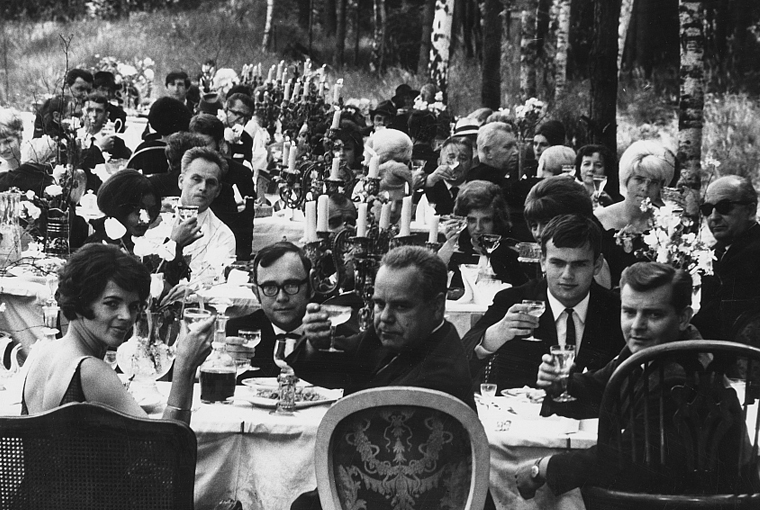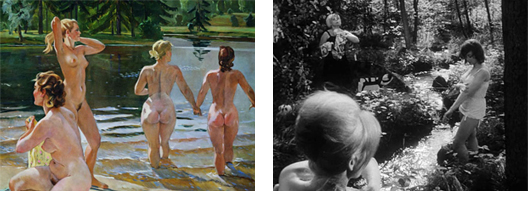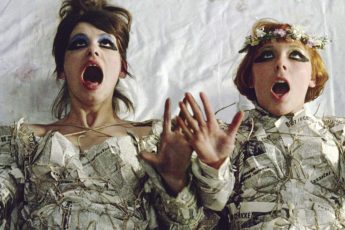Lessons of Freedom: 1965-1966
Jan Němec’s A Report on the Party and the Guests (O slavnosti a hostech, 1966)
Vol. 28 (April 2013) by Moritz Pfeifer
In 1966, Jan Němec produced his notorious A Report on the Party and the Guests. The movie, only slightly over 60 minutes, follows a group of bourgeois lovers who enjoy a quiet picnic in the countryside when they are suddenly beset by another, larger group of grim looking, yet politely smiling men in grey suits that invite them to join their own party on the side of a nearby lake. Before they even realize what’s going on, the group has to go through an awkward interrogation procedure set by a guy who calls himself Rudolf. Although this all happens in the manner of a game, things get more serious when one of the guests refuses to play along and consequently gets chased and beaten. Later at the party another guest escapes unnoticed, and when the group finally finds out that he is missing, they decide to look for him with dogs and a barrel. By then it becomes clear that the party is actually the Party (with a capital p), and the whole film an allegory of the absurd routines of totalitarian oppression, and society’s (the guests’) passive role in playing along. Without a doubt, the director perfectly succeeds in finding symbols for a reality he was not allowed to show ad pedem litterae. But is the film really that allegorical? Why, for example, did the director decide to set his story in a frame of festivity and celebration, when more somber allegories, like the urban nightmares similar to those of Orwell or Kafka, could have dramatized his point?
In the beginning of the film, the group of lovers just wants to enjoy having a sunny time in the fields. In one of the first scenes, the women take a bath in a nearby river, and the whole thing looks like an Arcadian fantasy [picture 1]. All of this makes it seem as though the picnickers are really enjoying a good amount of real happiness and freedom before totalitarianism would mark the end of their day. The question I want to ask is what kind of criticism Němec is doing here. He clearly seems to dissent with governmental intervention on questions concerning happiness and freedom. But happiness and freedom without that intervention still awkwardly reflects the iconography favored by that government. The happy-life scenes of the movie’s first five minutes can easily be compared to Socialist Realism paintings in the style of Dementi Shmarinov or Alexander Deineka. So, maybe then, the oppressive men in gray suits are more like a prolongation of the feast than a bunch of party poopers. One of the reasons for Němec to equate Soviet-style dictatorship with an outdoor feast is perhaps to show that this kind of highspirited totalitarianism is part of the system, the order to be merry its chief rationale. After all, social happiness is a necessary consequence of Communism’s advent.
A.A. Deineka – Bathers (1955) and Bathing Guests in A Report on the Party and the Guests
Němec’s film not only criticizes the government, but also the society that brings that government about. The picnickers only decide to play along because all that they’ve been doing all along anyway, is play. This, I believe, shows a reality not many people of Němec’s time were ready to see. Most films of the mid-1960s were quick to point at government hypocrisies such as perverted efforts to hide oppression behind a veil of big ideas – happiness, equality, freedom, and so on. But few were also willing to see the connection between these ideas and a system using them to justify social control. Němec’s A Report on the Party and the Guests is one of the few films that were ready to sacrifice not only the hypocrisy of these ideas, but also the ideas themselves. A Report on the Party and the Guests denounces the Party and the feast.
Here’s a selection of critical films that were shot in the former Eastern Bloc during this time (for a short explanation of why each of these films are critical, see the footnote1 below): Yugoslavia: Man is Not a Bird (Čovek nije tica, Dušan Makavejev, 1965); Poland: Walkower (Walkover, Jerzy Skolimowski, 1965); Hungary: Cantata (Oldás és kötés, Miklós Jancsó, 1966); Romania: Sunday at 6 (Duminică la ora 6, Lucian Pintilie, 1965); Ukraine: A Well for the Thirsty (Krynytsia dlia sprahlykh, Iurii Illienko, 1966); Armenia: Kyiv Frescoes (Киевские фрески, Sergei Parajanov, 1965); Georgia: Falling Leaves (Giorgobistve, Otar Iosseliani, 1966); Russia: A Nasty Story (Скверный анекдот, Alexandr Alov and Vladimir Naumov, 1965), and Andrei Rublev, (Андрей Рублёв, Andrey Tarkovsky, 1966). Czechoslovakia: Daisies (Sedmikrásky, Věra Chytilová, 1966), and A Report on the Party and the Guests (O slavnosti a hostech, Jan Němec, 1966).
With the exception of Jancsó, Skolimowsi, Pintilie, and Makavejev, all the films were either shelved or banned (Skolimowski and Pintilie had to wait for their next films, and Makavejev for another two films, before they would also be banned). If you watch these films, you get the feeling that things are not going too well. An overwhelming majority of them depict the experiences of deeply melancholic, disillusioned, and impotent men, and only rarely stretch out their plot over more than one man (as in Sunday at 6 or Walkover).2 They all show a profound understanding of the system’s failure at guaranteeing the most basic level of freedom. And yet, they also all have some actual, real, and tangible point of reference this lack of freedom is sized up against – fraternal harmony, love, freedom of expression, a better past, and so on and so forth. The best example for this is probably the melancholic character that was the subject of so many films of the 1960s (Man is Not a Bird, Walkower, Cantata, Well for the Thirsty, Kyiv Frescoes, Andrei Rublev). These young men (most of them in the age of their creators) would feel all lonely, and existentially anxious about the false promises of great ideas. Last month, I discussed this anxiety in Miklós Jancsó’s film Cantata, which tells the story of a doctor who fails to live up to his (Communist) ideals, and tries to reestablish ties to his family that is presented in the film as living a more happy, traditional life. Where did these ideas come from? For most people living in the 1960s, it seems unlikely that there was an actual, real, and tangible reference point where these values could have been observed. WWII, rampant Stalinism with post-WWII purges would have probably made any belief in a better past look like nostalgia without memory.
One reason why many directors of Němec’s generation may have been so sad, disillusioned, and hurt by the hypocrisy of government imposed happiness is that they had a reason to believe in it. In the mid-1960s, the cold war celebrated its 20th anniversary. By then, a whole generation on both sides of the Iron Curtain had grown up with propaganda that tried to disseminate ideas about the supremacy of its respective political system. American Dream vs. New Soviet Man. Movies, like other forms of propaganda, played an active role in selling these ideas and making the cold war cultural. Although the Soviet Union saw a decline of film productions during the 1950s, their domestic propaganda was no less successful, the peak of it being the almost three-hour film The Fall of Berlin that glorified Stalin’s WWII biography. In Czechoslovakia, comedies, fairy-tales, and light-hearted dramas by directors like Bořivoj Zeman (Angel in the Mountains, The Proud Princess, Once Upon a Time There Was a King) or the optimistic, and often patriotic animations of Jiří Trnka (The Prince Bayaya, Old Czech Legends) would reach wide popularity. Children would learn what happiness meant from movies like The Proud Princess, which tells the story of a spoiled, unhappy princess that goes through a character development when she starts living with a bunch of peasants. For the record: in the U.S., the amount of films that showed, year after year, utopian optimism about the American way of life, and anxiety-ridden pessimism about governmental alternatives would reach the hundreds. (I invite the reader to either take my word for this, or start watching a bunch of these films like Invasion U.S.A., I Married a Communist, I was a Communist for the FBI, The Red Menace, Guilty of Treason, Big Jim McLain, The Bell, My Son John, Walk East of Beacon, and remember that they were not meant to be ironic.)
It may be hard to grasp how these movies were able to attract thousands of viewers, and how moviegoers tolerated or even enjoyed the naivety and, more than often, blatant indoctrination of these films. And yet, it is not at all clear whether the moral kind of patriotism these films advertised was a top-down phenomenon, planned and executed by the ruling governments, or a true popular sentiment coming perhaps from the feeling that the post-WWII era was, for many, the first experience of real peace and prosperity. Many people believe that it was psychologically necessary for society to believe in their own happiness, as a sort of survival mechanism against the traumatic experience of WWII.3 Whatever the reasons, it remains true that young men and women both in the Eastern Bloc and the U.S., who were in their mid-to-late twenties in 1965, were constantly exposed to cultural images made by people who acted more like spiritual guides, coaches, and ego-boosters than like artists. This would, of course, only encourage the conflicting cues of fear and freedom that were part of the whole Cold War double-bind: we’re free, but we’re so afraid that someone will take that freedom from us that we legitimize all sorts of freedom-limiting things to protect it.
That freedom was not a question that could be resolved by the House Committee on Un-American Activities, The Motion Picture Association (in the U.S.), the KSČ (in Czechoslovakia) or Goskino (in the Soviet Union), nor of any other mouth-piece of social beliefs, would fully kick in by the mid-1960s on both sides of the Iron Curtain. In a kind of grand awakening, these films would flip the enthusiasm upside down. Pro-military films were replaced by anti-war films; films about the bliss of the common man by films about existential desolation; films about the grandeur of political systems by films about political nightmares. They wouldn’t, however, drop the values. Instead, they neatly separated the grand ideas their respective governments sold to society over the previous decade from their application in reality. That the existence of these ideas were somehow part of the system they were fighting against did not occur to most of them.
This, I believe, is the allegory A Report on the Party and the Guests is talking about. The picnickers are so attached to the condition of having a great time, that they are willing to sacrifice everything for it to continue, even under the condition that they actually stop having a great time. Thus the hypocrisy does not only lie in the host of the Party, but also in the picnickers who accept cruelty, injustice, and humiliation, as long as it is presented to them in the form of the initial condition that is so dear to them. The lesson of A Report on the Party and the Guests is that it is not enough to find contradictions in others, to point at the government’s lies, and false promises, when a social demand is the reason for these lies and promises to exist in the first place.
Today we, the witnesses of out time, have learned the lesson. We have a much harder time to make out what we fight, breathe, believe, and talk about in a meaningful way. It’s as if we really live in the absence of great concepts, narratives, and ideas, a condition that many people in the last decades of the twentieth century defended and considered worth fighting for (mostly with a bunch of concepts, narratives, and ideas).4 If some character in a movie of today would justify his depression in terms of him not being free, we would probably take it to be ironic. The reason why we can’t make sense of such a person may not be so different from the reasons Němec had when he criticized society’s demands for big ideas. We have so effectively deconstructed (i.e. turned something clear and straight forward into something taboo because it has been morally abused) things like freedom that we no longer mention them. This sounds like some form of nihilism. Of course, the belief in nothing keeps expectations low. Others may say that we believe in actions, not in words or ideas. Are we less melancholic? Probably not. As long as actions will have some ideal way of turning out, there will always be a reason to get depressed about failure.




Leave a Comment